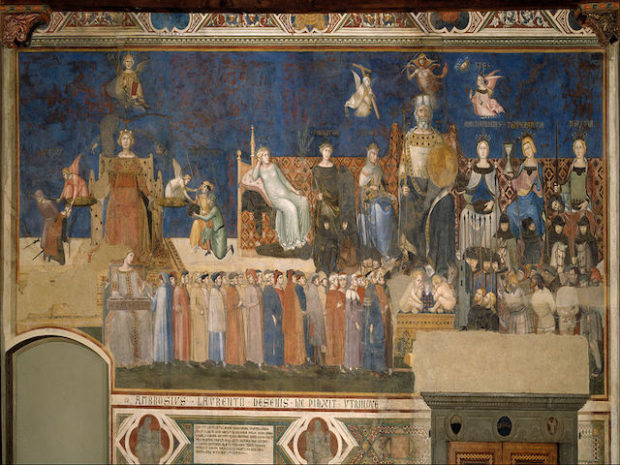You have no items in your cart. Want to get some nice things?
Go shopping
A little while ago, an old friend who lives in another part of the country was visiting my cottage for the first time. To our mutual surprise, we discovered we both had a print of Ambrogio Lorenzetti’s fresco “Allegory of Good Government” hanging on our respective walls. Nor are my friend and I alone: Niall Ferguson, the historian, in his latest provocative history, The Square and the Tower (2018), reveals that the very first picture he ever bought was a print of Lorenzetti’s Allegory. Lorenzetti (c1290–1348) painted the fresco in a room in the Palazzo Pubblico of the medieval republic of Siena. The fresco was a revolutionary artefact of the fourteenth century. It portrayed a vista of an idealised Siena and the surrounding countryside: it is probably the first true landscape painting in Europe since the Ancient Roman frescos, and the extravagant city roofscape is testament to Lorenzetti’s innovative experiments with perspective. But it was not for these reasons alone that I and the old friend (and, I imagine, Niall Ferguson) had given houseroom to the print.
The fresco is one of a pair: on the opposite wall is the “Allegory of Bad Government.” The Palazzo room in which both are to be found is The Room of Nine, where the Council of Nine met nearly seven hundred years ago to govern the republic. The didactic purpose of the frescos is clear from the strap-line at the base of the Allegory of Good Government, which begins “Turn your eyes to behold her, you who govern her…” Bad Government depicts an enthroned tyrant wielding a dagger and flanked by the figures of Cruelty, Deceit, Fraud, Fury, Division and War; the streets are empty, the houses are damaged, the only trader is the armourer; and the countryside is ravaged – a location for advancing armies. Good Government shows celebratory dancers in the street, artisans at their various trades in the shops, and builders among the roof tops raising a new tower; in the countryside, peasants are working in productive fields, huntsmen are riding forth to find game, and packhorses are making their way to the city, laden with goods. The message to the Council of Nine seems clear: take heed that you govern wisely to bring happiness and prosperity to the republic.
Yet things are not always as they seem. The Sienese Republic lasted four hundred years, but it was only intermittently and infrequently democratic. The Council of Nine were a group of merchant-princes, drawn from families that had long become extraordinarily wealthy from banking and trading: Sienese families had been bankers to the Pope and had dispatched traders to travel as far as Persia. The Allegories were pieces of public art, commissioned by the Council. Were they commissioned to instruct, or to celebrate? Langton Douglas’s classic 1902 A History of Siena is unambiguous: “…the whole composition is a tract, written in buon fresco, with the object of glorifying the plutocratic regime”. Certainly, the Council were no strangers to glorifying projects: the Torre del Mangia – the great bell tower of the Palazzo – constructed around the same time as the frescos, was deliberately raised to be the tallest building in all Italy.
However, we (who are surrounded by public art) must recognise that not all artists who receive a commission embark upon projects of glorification of their public patrons. There are, of course, occasions when the aims of the artist and the patron are so contradictory that the project flounders. A famous and extreme example would be John D. Rockefeller Junior’s demand that Diego Rivera remove the portrait of Vladimir Lenin from the mural commissioned to adorn the Rockefeller Centre in the 1930s. But more often than not, commissioners are prepared to grant some license, and accept some gentle instruction, from the commissioned.
In 1355, the citizens of Siena rose in revolt, expelled the Nine, and established a Magistry of Twelve, chosen from among the small traders of the city. But by that time, Lorenzetti had been dead for eight years, a victim of the bubonic plague that killed half the inhabitants of the city – a catastrophe from which Siena never completely recovered. Who is now to say whether Lorenzetti was the brilliant tool of the Council of Nine, or the harbinger of the Magistry of Twelve?
About Michael Bloor
Michael Bloor is a retired sociologist living in Dunblane, Scotland. A published poet and essayist, he has recently discovered the exhilarations of short fiction, with pieces published in Breve New Stories, Ink Sweat & Tears, Fictive Dream, Platform for Prose, the Flash Fiction Press, Flash Fiction Magazine and Scribble.



